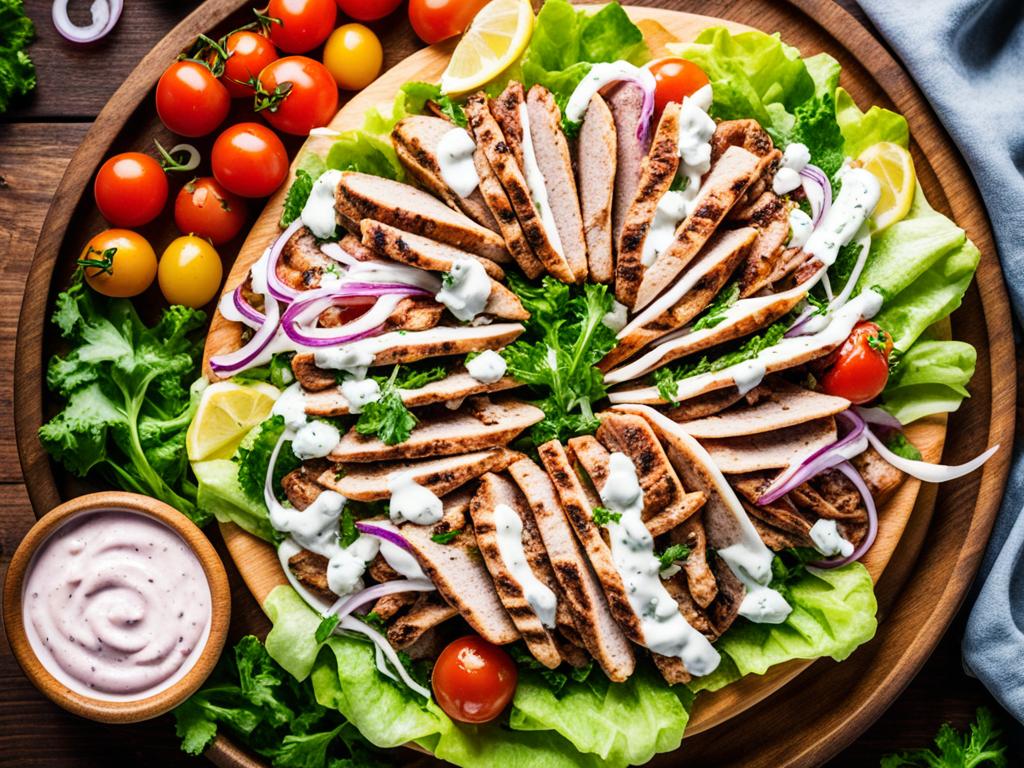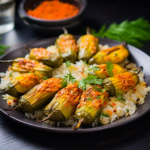Embark on a culinary journey to the heart of Greece with my Authentic Greek Pork Gyros recipe. This delightful twist on classic Greek street food stands out for its tender, flavorful pork marinated to perfection. For an optimal flavor profile, the meat should be brined for 24 hours and marinated for at least 3 hours. From the succulent pork shoulder cutlets and sliced pork belly to the tangy Tzatziki sauce and warm Pita bread wraps, every element is crafted to outshine your favorite restaurant versions. This dish is slow-cooked in the oven at 350°F, with a total cooking time of 1 hour and 30 minutes, ensuring a savory Mediterranean cuisine experience that is sure to impress. After cooking, assemble your gyros using fresh toppings and embrace the ultimate home-cooked gyro cones adventure.
Key Takeaways – Greek Pork Gyros
- The best combination for traditional Greek gyro is pork shoulder cutlets and sliced pork belly.
- Brine the meat for 24 hours to ensure tender and juicy results.
- Marinate the pork for at least 3 hours to enhance flavor.
- Cook the gyro at 350°F for 1 hour and 30 minutes, rotating every 30 minutes for even cooking.
- This recipe serves six and takes a total of 3 hours and 35 minutes to prepare and cook.
- Served with warm pita bread, shredded romaine lettuce, chopped grape tomatoes, red onion slices, and sweet chili sauce.
Introduction to Greek Pork Gyros
Greek Pork Gyros have captivated taste buds around the globe, offering a delightful combination of marinated pork, savory spices, and fresh ingredients. Served traditionally in a grilled pita and topped with a tangy Greek Yogurt Dip, this dish stands as a true pillar of Greek street food. Let’s explore what makes Greek Pork Gyros so unique, their rich history, and how they compare to other Mediterranean delicacies like Souvlaki and Turkish döner kebab.
What Makes Greek Pork Gyros Special
Unlike many other dishes, Greek Pork Gyros owe their distinctive flavor to the careful marination process and meticulous cooking technique. Traditionally, the marinated pork is slow-cooked on a vertical rotisserie, allowing the layers of meat to baste in their own juices and acquire an irresistible, crispy exterior. This method contrasts with the horizontal rotisserie used historically by Ottoman Turks and adopted later for Turkish döner kebab. Gyros in Greece are usually made from pork, while variations around the world include chicken, beef, or lamb. This adaptability has helped the dish remain beloved across various cultures.
Peter Parthenis: The Greek Who Made Gyros Popular in America
Origins and History of Gyros
The word “gyros” derives from the Greek word “γύρος,” meaning “circle” or “turn,” echoing the Turkish word “döner.” Introduced to Americans in 1965 by George Apostolou in Chicago, Gyros quickly became a fast-food sensation. Gyro cones and the vertical rotisserie gained popularity due to their efficient cooking process, which turns thin slices of meat into a succulent feast. The Greek-American version of Gyros, featuring a mix of finely ground beef and lamb, reflects how immigrant communities brought their culinary traditions to new lands, blending and adapting them along the way.
Comparisons with Other Mediterranean Dishes
Though they share similarities, Greek Pork Gyros, Souvlaki, and Turkish döner kebab each have distinct characteristics. Gyros are often confused with Souvlaki, another popular Greek dish made from skewered meat, usually pork or chicken. However, Souvlakis and Gyros hold equal ground in Greece. The Halifax donair in Canada, another variation, sprung from the adaptation of Greek Gyros. Compared globally, Gyros seem to be more recognized, particularly in the US, where Americans consume over 300,000 Gyros daily. Despite different toppings and presentations, such as ketchup or mustard in northern Greece, these dishes continue to celebrate the rich flavors and heritage of Mediterranean cuisine.
Essential Ingredients for Authentic Pork Gyros
The journey to achieving the authentic taste of Greek Pork Gyros starts with carefully selecting the right cut of pork, followed by a precise marinade and fresh, complementary toppings.
Choosing the Right Cut of Pork
For traditional Greek gyros, the best combination includes both pork shoulder cutlets and sliced pork belly. These cuts balance richness and tenderness. The pork shoulder cutlets provide a leaner texture, while the pork belly adds flavorful fat that’s essential for the crispiness and taste of the gyros.
Key Spices and Herbs
The flavor of the gyros is significantly enhanced by using a range of key spices and herbs. Begin with a basic brine marinade of sea salt, sugar, and bay leaves to ensure the meat is moist. Spice it up with sumac, oregano, chili flakes, and fresh thyme for a robust and aromatic profile. Marinate the pork for at least three hours—though marinating it for a full 24 hours is recommended for the best results.
Fresh Vegetables and Toppings
No gyro is complete without the right toppings. Fresh vegetables such as tomatoes, onions, and lettuce add a refreshing crunch. Complement these with a creamy Greek Yogurt Dip, also known as tzatziki. In the gyros, Marinated pork slices should be wrapped in warm pita bread, along with these fresh ingredients and topped with a drizzle of your homemade tzatziki sauce.
For those aiming to create a true Greek experience, here’s a detailed nutritional breakdown and essential cooking statistics:
| Yield | 6 servings |
|---|---|
| Calories per serving | 586 calories |
| Total Fat | 46 grams |
| Saturated Fat | 13 grams |
| Trans Fat | 0 grams |
| Monounsaturated Fat | 23 grams |
| Polyunsaturated Fat | 5 grams |
| Carbohydrates | 10 grams |
| Dietary Fiber | 3 grams |
| Sugars | 3 grams |
| Protein | 34 grams |
| Sodium | 680 milligrams |
Brining Your Pork for Extra Tenderness
Brining is a crucial step in ensuring your Greek Pork Gyros are exceptionally tender and flavorful. The process involves soaking the pork in a solution of sea salt and brown sugar, which draws moisture into the meat and enhances its overall taste.
Why Brine Your Meat?
Brining meat, especially for a meat rotisserie, is not just about adding moisture; it also infuses the pork with a depth of flavor from the added spices and herbs. The salty solution created by the sea salt and brown sugar interacts with the proteins in the meat, breaking them down slightly and making the pork more tender. Fresh herbs, bay leaves, and whole peppercorns in the brine balance the flavors, ensuring every bite is juicy and delicious.
Simple Brine Recipe
Creating a pork brine is simple and requires just a few ingredients:
- 1 gallon of water
- 1 cup of sea salt
- 1/2 cup of brown sugar
- 2 bay leaves
- 1 tablespoon of whole peppercorns
- various fresh herbs such as thyme and rosemary
Combine all ingredients in a large container, stirring until the sea salt and brown sugar are completely dissolved. Submerge the pork shoulder cutlets and pork belly slices in the solution, ensuring they are fully covered.
How Long to Brine for Best Results
For optimal results, the pork should be brined for at least 24 hours. This allows sufficient time for the sea salt, brown sugar, and fresh herbs to penetrate the meat fully, ensuring it is properly seasoned throughout. To maintain the right flavor balance, make sure the pork brine is refrigerated during this period. Once brined, the pork is ready to absorb even more flavor from the marinade and cook perfectly, delivering that authentic juicy-crispy texture characteristic of traditional Greek gyros.
Check out the easy-to-follow brining and marinating process and see the difference it makes in your homemade gyros!
| Brine Ingredients | Amount | Purpose |
|---|---|---|
| Sea Salt | 1 cup | Seasoning, moisture retention |
| Brown Sugar | 1/2 cup | Flavor enhancement, texture improvement |
| Bay Leaves | 2 leaves | Natural flavor addition |
| Whole Peppercorns | 1 tablespoon | Bold, spicy notes |
| Fresh Herbs (Thyme, Rosemary) | According to preference | Aromatic and fresh taste |
The Perfect Marinade for Greek Pork Gyros
Creating the perfect marinade for your Greek Pork Gyros is an art that combines the right ingredients with best marinating practices to yield the most flavorful, tender meat.
Marinade Ingredients
The base of this delicious pork gyro marinade includes ½ cup of extra virgin olive oil, 2 tablespoons of white wine vinegar, 1 tablespoon of honey, 1 tablespoon sumac, 1 tablespoon dry oregano, 1 tablespoon freshly ground pepper, 1 teaspoon chili flakes, 2 teaspoons sea salt, and 2 tablespoons fresh herbs. These aromatic spices and ingredients work together to enhance the flavors of the pork.
Best Practices for Marinating
For optimal results, it’s crucial to start with meat that has been brined for at least 24 hours. Once brined, ensure the pork is patted dry before introducing it to the marinade. The meat should be coated evenly with the marinade mixture, allowing the extra virgin olive oil and white wine vinegar to penetrate deeply. Place the marinated pork in a sealed container or vacuum-sealed bag, which helps to expedite the infusion process.
Quick Marinating Tips
For those short on time, marinating the pork for a minimum of 3 hours can still yield great results, though overnight marination is preferable for deeper infusion. If a vacuum sealer is available, use it to reduce the marination time by increasing the marinade’s contact with the meat. Remember to incorporate fresh herbs and honey a few hours before cooking to maximize their freshness and flavor.
Cooking Methods for Pork Gyros
When it comes to preparing delicious pork gyros, having the right cooking method can elevate the dish to new heights. Let’s explore the different cooking options to achieve the ideal flavor and texture for your gyro meat:
Using a Vertical Rotisserie
The vertical rotisserie, or vertical spit, is a traditional and popular method. This technique allows the meat to roast evenly as it slowly turns, ensuring a perfect balance of tender, juicy interior and crispy exterior. Ideal for both pork and chicken, this method mimics the classic Mediterranean street food experience, resulting in authentic and flavorful gyros.
Oven-Baking Your Gyros
If you don’t have access to a vertical rotisserie, don’t worry—you can still create excellent pork gyros in your oven. The recommended oven baking procedure involves stacking the meat on a rimmed baking sheet and cooking it at 350°F for 1 hour and 30 minutes. Remember to rotate the pan every 30 minutes to ensure even cooking. This method delivers a convenient and effective way to enjoy tender and flavorful gyro meat.
Grilling Options and Tips
Grilling is another fantastic option for cooking gyros. Using a horizontal grill with frequent rotation helps achieve a delightful balance of charred edges and succulent interiors. Techniques such as horizontal grilling and high heat frying are excellent ways to lock in the juices while creating that signature crispy exterior. Any meat that is slightly fatty, like pork belly or shoulder, will yield the best results with this method.
| Cooking Method | Temperature | Cooking Time |
|---|---|---|
| Vertical Rotisserie | N/A | Varies by device |
| Oven-Baking | 350°F | 1 hour 30 minutes |
| Grilling | High Heat | Until crispy |
Overall, whichever method you choose, ensure that the cooking process involves high heat to achieve flavorful and tender pork gyros that will impress any palette.
Serving Suggestions and Presentation
Presenting Greek Pork Gyros is an art that combines taste with visual appeal. Whether it’s a gyros platter or a perfect gyro wrap, the right sides and sauces can elevate the entire experience.
Pairing with Sides and Sauces
Pairing *gyro* with the right sides and sauces is crucial. Classic choices include tzatziki, hummus, and spicy whipped feta. Fresh Greek salad and pickled vegetables are excellent additions. These sides and sauces not only enhance the taste but add vibrant colors to the spread. Key elements from the Greek pantry staples, like olive oil and oregano, can also add a touch of authenticity to the meal.
Serving Gyros on a Platter
Creating a gyros platter is an excellent way to serve this iconic dish for gatherings. Start with homemade pitas, layered with generously sliced gyros meat. Arrange fresh vegetables like tomatoes, onions, cucumbers, and sides of fried potatoes or grilled vegetables like bell peppers and zucchini. Tzatziki and a sprinkle of tangy smoked paprika round off the platter beautifully.

Creating the Perfect Gyros Wrap
The perfect gyro wrap is all about balance. Start with warm, slightly toasted pitas. Add a generous amount of gyro meat, then layer on the vegetables – fresh tomatoes, onions, and perhaps some shredded lettuce or sliced cucumbers. Don’t forget tzatziki or spicy whipped feta for that creamy texture. Roll it up tightly, making sure all the flavors meld together with each bite.
| Elements | Description |
|---|---|
| Gyro Meat | Usually pork or chicken, cooked on a vertical spit |
| Pita Bread | Homemade or store-bought, warmed and almost toasted |
| Vegetables | Fresh tomatoes, onions, cucumbers, and occasionally lettuce |
| Sides and Sauces | Tzatziki, spicy whipped feta, and pickled vegetables |
| Final Touch | Smoked paprika for added flavor |
Making Homemade Pita Bread
Creating homemade pita is a gratifying process that enhances any Mediterranean dish, especially gyros. This pita bread recipe is straightforward yet rewarding, yielding perfect pitas every time.
To start, gather your ingredients: flour, yeast, warm water, sugar, salt, and olive oil. Combine these elements, kneading the dough until it is smooth and elastic. It’s essential to let the dough rise until it doubles in size, typically around one to two hours.
Baking Greek pitas requires a hot oven, preheated to about 500°F. This high temperature ensures the characteristic puffiness. Roll the dough into small rounds, and bake each piece for 3-5 minutes until they puff up. Keep a close eye on them, as overbaking can lead to a crunchy rather than soft finish.
Once out of the oven, let the homemade pita cool slightly before serving. I recommend keeping them warm by wrapping them in a clean kitchen towel. This step preserves the softness and makes them perfect for folding into gyro wraps, embodying the quintessential Greek street food experience.
Here’s a closer look at some key points:
| Ingredients | Preparation Time | Baking Time | Key Tips |
|---|---|---|---|
| Flour, yeast, water, sugar, salt, olive oil | 2 hours | 3-5 minutes per pita | Preheat oven to 500°F, watch closely while baking |
Baking Greek pitas at home is more than just a culinary task; it’s immersing in a true Mediterranean bread-making tradition. This recipe not only elevates your gyro game but also brings the authentic flavors of Greek street food directly to your kitchen.
Preparing Traditional Tzatziki Sauce
Creating a Traditional Tzatziki Sauce is essential for an authentic Greek culinary experience. This refreshing Greek yogurt dip perfectly complements pork gyros, adding a tangy and creamy contrast to the savory meat. Let’s explore the ingredients and steps to make this delightful cucumber yogurt sauce.
Ingredients for Authentic Tzatziki
- 1 cucumber
- 2 cloves of garlic
- 1/4 cup extra virgin olive oil
- 500g of full-fat Greek yogurt (18 ounces)
- 1-2 tablespoons of red wine vinegar
- Salt and freshly ground pepper
- Fresh dill (optional)
Step-by-Step Preparation
- Start by peeling and grating the cucumber. Place the grated cucumber in a sieve, sprinkle with a pinch of salt, and let it drain for about 30 minutes to remove excess water.
- In a mixing bowl, combine the full-fat Greek yogurt, minced garlic, and red wine vinegar.
- Add the drained cucumber to the yogurt mixture, followed by extra virgin olive oil.
- Season with salt and freshly ground pepper to taste, and stir in some fresh dill if desired for an added burst of flavor.
- Mix everything thoroughly until you achieve a creamy and well-blended consistency.
Storing and Serving Tzatziki
Once your Greek Yogurt Tzatziki is prepared, transfer it to an airtight container and store it in the refrigerator. This Traditional Tzatziki Sauce can be made ahead of time and will stay fresh for up to a week, making it a convenient addition to many meals. Serve it as a dip, a spread, or a side sauce with your pork gyros for an authentic Greek feast.
Common Mistakes to Avoid
Crafting the perfect Greek Pork Gyros can be a rewarding experience, but there are common cooking pitfalls that can significantly detract from the quality of your dish. One of the most frequent mistakes is overcooking the pork, which can result in a dry and tough texture. Timing is crucial; ideally, the cooking time should not exceed 20 minutes to maintain the juiciness of the meat.
“In Greece, gyro traditionally consists of pork rather than lamb or beef, showcasing a unique difference in meat preferences compared to American gyro options.”
Underscoring the flavor with proper seasoning is another challenge. Many home cooks err on the side of caution, leading to underseasoned meat. Ingredients like fresh lemon juice, smoked paprika, and Greek yogurt are essential in the marinade for enhancing the flavors and tenderness of the pork tenderloin.

When it comes to Tzatziki preparation, consistency and flavor are key. Ensure that the cucumber is well-drained to avoid a watery sauce, and do not skimp on garlic and fresh herbs like dill. Tzatziki can be kept refrigerated for 1-2 days, so Gyro meal planning can include making sauces ahead of time without compromising freshness.
- Over 80% of Americans are familiar with gyros, indicating high popularity and demand for Greek cuisine in the United States.
- Pork tenderloin is the most expensive cut of pork, suggesting that the cost of ingredients for homemade gyros may vary depending on the choice of meat.
- The typical weight of ready-made souvlaki pieces ranges between 75 and 100 grams, while the recommended weight for homemade souvlaki pieces is around 50 grams each to ensure consistent cooking.
Effective Gyro-cooking techniques include maintaining a high pan temperature to achieve the desired dark brown color on the meat. This color is a result of the sugar in the marinade caramelizing, adding depth to the flavor. Additionally, splitting the meat into 3-4 batches for cooking ensures even heat distribution and prevents overcrowding in the pan.
By being mindful of these potential mistakes and applying precise Gyro meal planning, you can elevate your Greek Pork Gyros to a restaurant-quality dish, impressing your friends and family with an authentic and delicious Mediterranean feast.
Why You Should Try This Greek Pork Gyros Recipe Today
If you’re a fan of Mediterranean cuisine, this authentic Greek Pork Gyros recipe is a must-try. Originating from Greece, gyros have become a beloved Greek street food classic, showcasing the vibrant flavors and traditions of Greek cooking. Taking part in this festive cooking experience at home not only brings the delight of a traditional gyros meal to your table but also introduces you to the benefits of the Mediterranean diet, known for its healthful and balanced approach to eating.
This recipe focuses on combining good quality pork tenderloin, brining and marinating techniques to infuse the meat with robust flavors. By marinating the pork gyros for at least a couple of hours and sautéing them to perfection, you ensure a deliciously tender and savory outcome. Traditional Greek pita bread is the preferred wrapping, baked and brushed with oil for that perfect bite, while garnishes such as tzatziki sauce, red onion, and tomato slices complete the ensemble, making every mouthful a true Greek street food classic.
With accessible ingredients and detailed steps, this Greek Pork Gyros recipe demystifies the process of creating a restaurant-quality dish at home. From specific quantities of red wine vinegar, olive oil, and various spices to the preparation of tzatziki sauce by blending olive oil and garlic with grated cucumber and yogurt, every detail contributes to an authentic and flavorful meal. Embrace this culinary journey today, and savor the rich flavors of a gyros meal that’s a true celebration of Greek cuisine.
FAQ
What are the key ingredients for making authentic Greek Pork Gyros?
The key ingredients include pork shoulder cutlets and pork belly, a brine made with sea salt and brown sugar, a marinade with extra virgin olive oil, white wine vinegar, honey, and sumac, and traditional Greek spices like oregano and chili flakes. Fresh vegetables and homemade Tzatziki sauce are also essential.
How does brining the pork help in making tender gyros?
Brining involves immersing the pork in a sea salt and brown sugar solution with spices like bay leaves and whole peppercorns. This enhances moisture and flavor, ensuring the pork remains juicy and tender after cooking.
What’s the difference between Greek Pork Gyros and Souvlaki?
While both are popular Greek dishes, Pork Gyros are made from thinly sliced, marinated pork cooked on a vertical rotisserie, while Souvlaki consists of skewered and grilled meat chunks. Gyros are typically served in pita bread wraps, whereas Souvlaki can be served on skewers with a side of pita.
What cooking methods can I use for preparing pork gyros at home?
You can prepare pork gyros using a vertical rotisserie for even roasting, oven baking by stacking pork slices on a rimmed baking sheet, or grilling the meat until crispy. Each method provides a slightly different texture but ensures a flavorful outcome.
How long should I marinate the pork for gyros?
For the best flavor, it’s recommended to marinate the brined pork for at least 3 hours. For a deeper infusion of flavors, marinating overnight is ideal. If short on time, vacuum-sealing the pork can expedite the marinating process.
What sauces and sides pair well with Greek Pork Gyros?
Tzatziki sauce, made from Greek yogurt, cucumber, garlic, and dill, is a must-have. Additional sides that pair well include sliced tomatoes, onions, spicy whipped feta, and olives. Homemade pita bread elevates the gyro experience.
Can I make pita bread at home for my gyros?
Yes, you can make homemade pita bread by following a simple recipe. The process involves ingredients like flour, yeast, and olive oil, and precise baking techniques to achieve the soft, puffed texture integral to Greek street food.
What are the biggest mistakes to avoid when making Greek Pork Gyros?
Common mistakes include overcooking the pork, underseasoning, and improperly preparing Tzatziki sauce. To avoid these pitfalls, carefully follow brining and marinating instructions, monitor cooking times, and use fresh, authentic ingredients.
Why should I try making Greek Pork Gyros at home?
Making Greek Pork Gyros at home allows you to enjoy an authentic Greek street food experience with fresh ingredients and customized flavors. It’s also a part of the Mediterranean diet, offering a festive and healthy cooking project that’s both enjoyable and rewarding.


















